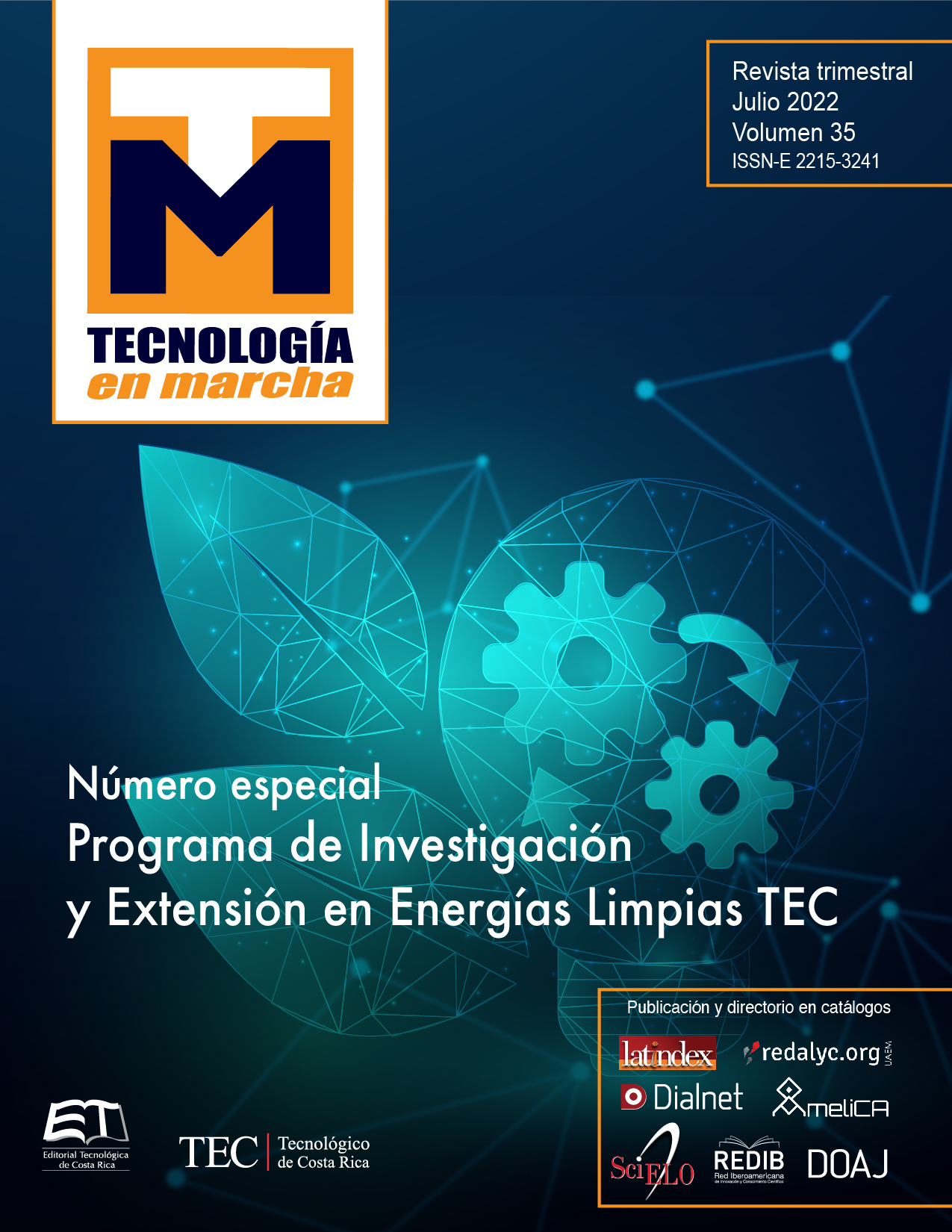Vertical evolution of wind’s turbulence intensity in complex terrain with obstacles
Main Article Content
Abstract
The market provides many small-scale wind turbine which are offered as a partial solution to reduce residential electricity bills. However, the reality is that in some cases the performance offered surpass the performance obtained, this is due to low wind speeds in residential areas and the effect of turbulence on the wind turbines. The objective of this work is to determine the local influence of obstacles on the turbulence and to describe the development of turbulence as a function of height, by comparing two meteorological towers: one placed between trees and the other placed in an area without nearby obstacles. In this way, it is intended to determine if within a specific landscape there can be found places with less turbulence due to a local reduction of the obstacles. The measurements obtained between October 2018 and September 2019 from the meteorological towers are then processed to obtain histograms to compare the evolution of turbulence intensity as a function of height. It is found that the turbulence depends on the height in the tower that is immersed between trees; it is smaller as the height increases. In addition, in the case of the tower without obstacles in its close environment, the turbulence is independent of the height. A turbulence intensity value close to 30% is reported as the most frequent among the data obtained by the ten anemometers used in the study.
Article Details

This work is licensed under a Creative Commons Attribution-NonCommercial-NoDerivatives 4.0 International License.
Los autores conservan los derechos de autor y ceden a la revista el derecho de la primera publicación y pueda editarlo, reproducirlo, distribuirlo, exhibirlo y comunicarlo en el país y en el extranjero mediante medios impresos y electrónicos. Asimismo, asumen el compromiso sobre cualquier litigio o reclamación relacionada con derechos de propiedad intelectual, exonerando de responsabilidad a la Editorial Tecnológica de Costa Rica. Además, se establece que los autores pueden realizar otros acuerdos contractuales independientes y adicionales para la distribución no exclusiva de la versión del artículo publicado en esta revista (p. ej., incluirlo en un repositorio institucional o publicarlo en un libro) siempre que indiquen claramente que el trabajo se publicó por primera vez en esta revista.
References
Z. Simic, J. G. Havelka and M. Bozicevic, “Small wind turbines – A unique segment of the wind power market,” Renewable Energy, vol. 50, pp. 1027-1036, 2013. https://doi.org/10.1016/j.renene.2012.08.038
A. Tummala et al., “A review on small scale wind turbines,” Renewable and Sustainable Energy Reviews, vol. 56, pp. 1351-1371, 2016. https://doi.org/10.1016/j.rser.2015.12.027
B. Kosasih and H. S. Hudin, “Influence of inflow turbulence intensity on the performance of bare and diffuser-augmented micro wind turbine model,” Renewable Energy, vol. 87, pp. 154-167, 2016. https://doi.org/10.1016/j.renene.2015.10.013
T. Rogers and S. Omer, “Yaw analysis of a micro-scale horizontal-axis wind turbine operating in turbulent wind conditions,” International Journal of Low-Carbon Technologies, vol. 8, nº 1, p. 58–63, 2012. https://doi.org/10.1093/ijlct/cts009
T. Kamada et al., “Effect of turbulence on power performance of a Horizontal Axis Wind Turbine in yawed and no-yawed flow conditions,” Energy, vol. 109, pp. 703-711, 2016. https://doi.org/10.1016/j.energy.2016.05.078
M. Tahani et al., “Investigating the effect of geometrical parameters of an optimized wind turbine blade in turbulent flow,” Energy Conversion and Management, vol. 153, pp. 71-82, 2017. https://doi.org/10.1016/j.enconman.2017.09.073
L. J. Lemes Stival, A. Kolodynskie Guetter and F. Oliveira de Andrade, “The impact of wind shear and turbulence intensity on wind turbine power performance,” Espaço Energía, vol. 27, 2017.
M. Talavera and F. Shu, “Experimental study of turbulence intensity influence on wind turbine performance and wake recovery in a low-speed wind tunnel,” Renewable Energy, vol. 109, pp. 363-371, 2017. https://doi.org/10.1016/j.renene.2017.03.034
K. Torres-Castro, C. Torres-Quirós and G. Richmond-Navarro, “Microgeneración de energía eólica en un entorno boscoso en Costa Rica: estudio de caso,” Tecnología En Marcha, vol. 34, no. 3, p. 61–69, 2021. https://doi.org/10.18845/tm.v34i3.5063
G. Richmond-Navarro, M. Montenegro-Montero and C. Otárola, “Revisión de los perfiles aerodinámicos apropiados para turbinas eólicas de eje horizontal y de pequeña escala en zonas boscosas,” Revista Lasallista de Investigación, vol. 17, no. 1, pp. 233-251, 2020. https://doi.org/10.22507/rli.v17n1a22
G. Richmond-Navarro, P. Casanova-Treto, and F. Hernández-Castro, “Efecto de un difusor tipo wind lens en flujo turbulento,” Uniciencia, vol. 35, nº 2, pp. 1-15, 2021. https://doi.org/10.15359/ru.35-2.7
V. Salas-Mora and G. Richmond-Navarro, “Safety Design of a Hybrid Wind-Solar Energy System for Rural Remote Areas in Costa Rica,” International Journal of Renewable Energy Research-IJRER, vol. 10, no. 1, pp. 33-44, 2020.
K.C. Anup, J. Whale and T. Urmee, “Urban wind conditions and small wind turbines in the built environment: A review,” Renewable Energy, vol. 131, pp. 268-283, 2019. https://doi.org/10.1016/j.renene.2018.07.050
G. Gualtieri, “Surface turbulence intensity as a predictor of extrapolated wind resource to the turbine hub height: method’s test at a mountain site,” Renewable Energy, vol. 120, pp. 457-467, 2018. https://doi.org/10.1016/j.renene.2018.01.001
J. Zhang et al., “Comparison of wind characteristics at different heights of deep-cut canyon based on field measurement,” Advances in Structural Engineering, vol. 23, nº 2, pp. 219-233, 2019. https://doi.org/10.1177/1369433219868074
A. Rigden, D. Li and G. Salvucci, “Dependence of thermal roughness length on friction velocity across land cover types: A synthesis analysis using AmeriFlux data,” Agricultural and Forest Meteorology, vol. 249, pp. 512-519, 2018. https://doi.org/10.1016/j.agrformet.2017.06.003
M. Rashid Abbas et al., “Assessment of Aerodynamic Roughness Length Using Remotely Sensed Land Cover Features and MODIS,” in IOP Conference Series: Earth and Environmental Science, 2021. https://doi.org/10.1088/1755-1315/722/1/012015
M. Giometto et at., “Effects of trees on mean wind, turbulence and momentum exchange within and above a real urban environment,” Advances in Water Resources, vol. 106, pp. 154-168, 2017. https://doi.org/10.1016/j.advwatres.2017.06.018
C. W. Kent et al., “Aerodynamic roughness variation with vegetation: analysis in a suburban neighbourhood and a city park,” Urban Ecosystems, vol. 21, p. 227–243, 2017. https://doi.org/10.1007/s11252-017-0710-1
L. Kang et al., “Experimental Investigation of the Aerodynamic Roughness Length for Flexible Plants,” Boundary-Layer Meteorol, vol. 172, p. 397–416, 2019. https://doi.org/10.1007/s10546-019-00449-0
DAVIS. (MANUAL) Anemometer for Vantage Pro2 (6410). En línea (última consulta 16/11/2021) https://support.davisinstruments.com/article/8nyitrnulq-manual-optional-ac-charger-kit-for-vantage-connect-hd-solar-power-kit-6710

